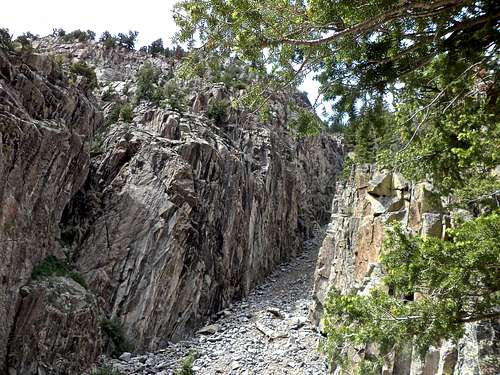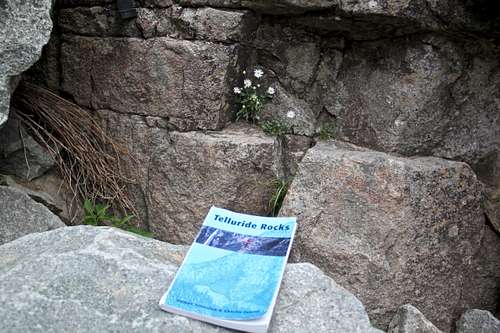-
 9069 Hits
9069 Hits
-
 89.95% Score
89.95% Score
-
 31 Votes
31 Votes
|
|
Canyon |
|---|---|
|
|
37.85600°N / 107.8312°W |
|
|
Trad Climbing |
|
|
Summer, Fall |
|
|
Overview
The climbing is at fairly high elevation, so summer storm can move in very fast. The approach involves an unpleasant scramble on large boulders, but the rock and the quality of climbing here make up for it.
The orientation of the canyon makes it possible to find shade at any time of the day, and it is well protected from the wind.
Some say that western slope of Colorado has a really bad rock, but there are several noteworthy crags with top notch climbing that rivals Colorado finest, and Cracked Canyon is one of those examples.
Cracked Canyon is home to many fine single pitch outings, and the nearby Ophir Wall with climbs up to 900 feet tall can extend heights. The surrounding scenery is stunning, and the nearby Telluride offers great cuisine and entertainment.
History of Climbing at Ophir/Cracked Canyon
In 1969, David Farney closed his Ashcrofters school in Aspen and moved operations to the Skyline Ranch near Telluride. One of his guides was Henry Barber of Boston, who began explorations of the Ophir Wall, partnering with Greg Davis. Barber made first ascent of some superb Ophir Wall lines, including the top to bottom dihedral system Hot Wee Wee.
in 1973, Bill Kees, the original Ophir Wall Bum and the goodfather of Telluride climbing, added classic routes such as Orange Peel, with Jack Koffman. This one pitch, 5.10 crack was hidden away in what would be known as Cracked Canyon.
In 1977 some strange news hit town, Royal Robbins moving to Telluride? As the Bumbs sat on barstools in the evenings and on porches of old Ophir cabins,images of rocks climbs flashed before their eyes. They knew the Californians would soon be exploring their crags, and they resolved to really get after it.
In the summer of 1978, Chris Vandiver joined Robbins in Telluride and the Rockcraft climbing school opened for business. That year, the total Telluride route count doubled. Especially popular were the short, steep cracks of Cracked Canyon, where many excellent routes were climbed, mostly by the Californians. Particularly painful for the Ophir Wall Bums was the first ascent of Javelin, the best looking crack in the Cracked Canyon. Strenuous, overhanging, and attempted on several occasions before the California invasion, it was led with an easy by Vandiver, and then by Royal Robbins.
The demand for climbing instruction in Telluride was limited and the Rockcraft school would last but a few years. Kees and others had much better success putting Telluride on the international climbing map by putting together Mountain Film in 1979. The first film festival on continent devoted solely to mountaineering.
In the summer of 1980, quite a collection of name climbers was gathered in this funky mountain town in the San Juans. Among them were the young California couple John Long and Lynn Hill. Lynn made the first ascent of Ophir Broke, solid 5.12, which was in that time the hardest crack climb in Colorado and even Yosemite had only a climb or two that were harder.
Getting There
Location: 8 miles southwest of Telluride, just off Colorado road 145. Turn into a small town Ophir, follow the main road, pass the tiny post office building. Park 120 meters past post office on a small pullout parking lot. Look for a small climber's trail up the steep slope among the trees. Follow this trail to the start of large boulder/talus section. This part of approach is unpleasant.
Approach Cracked Canyon by parking in roadside pullouts directly below the canyon. A rough access trail walks up through the forest and onto the steep talus slope below the canyon. Take care not to tumble unstable talus onto those below. More loose talus fills the steeple angled canyon floor. Again, use caution not to avalanche boulders down.
Routes
Rock Type: RhyoliteRed Tape
When to Climb
Summer and Autumn. Expect snow inside the canyon in the spring, and be aware of summer thunder storms in afternoons.Camping
Free camping is available in the small roadside meadow west of the Ophir Post Office and in the San Miguel Canyon below Ilium along Forest Road 625. Otherwise, head a few miles north on Colorado 145 to Sunshine Campground or south to Matterhorn Campground. Bring your own water if you camp at the wall base. The river water is contaminated with mine tailings.












